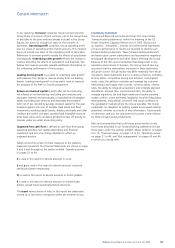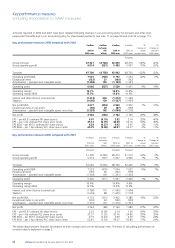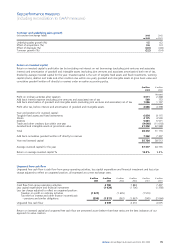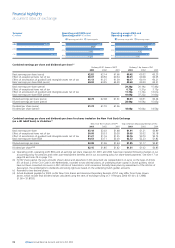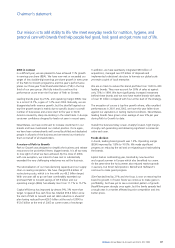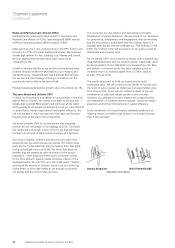Unilever 2003 Annual Report Download - page 16
Download and view the complete annual report
Please find page 16 of the 2003 Unilever annual report below. You can navigate through the pages in the report by either clicking on the pages listed below, or by using the keyword search tool below to find specific information within the annual report.
Unilever Annual Report & Accounts and Form 20-F 2003 13
About Unilever
Distribution and selling
Unilever’s products are generally sold through its sales force and
through independent brokers, agents and distributors to chain,
wholesale, co-operative and independent grocery accounts, food
service distributors and institutions. Products are distributed
through distribution centres, satellite warehouses, company-
operated and public storage facilities, depots and other facilities.
Exports
We sell our products in nearly all countries throughout the world
and manufacture in many of them. Inside the European Union we
make many of our products in only a few member countries, for
sale in all of them.
We also export a wide range of products to countries where we
do not currently make them. We often use this export trade to
develop new markets, usually relying on manufacturing facilities
in neighbouring countries, before building local manufacturing
facilities in such new markets.
Seasonality
Certain of our businesses, such as ice creams and prestige
fragrances, are subject to significant seasonal fluctuations in sales.
However, Unilever operates globally in many different markets
and product categories. No individual element of seasonality
is likely to be material to the results of the Group as a whole.
People
Our future success lies in the hands of the 234 000 people
who work for Unilever in around 100 countries. Harnessing,
developing and rewarding their skills, energy and commitment
is our priority.
Number of employees
Year end in thousands 2003 2002 2001 2000 1999
Europe 55 60 71 80 74
North America 20 21 22 39 22
Africa, Middle East
and Turkey 52 52 49 48 50
Asia and Pacific 77 82 85 84 71
Latin America 30 32 38 44 29
Total 234 247 265 295 246
People are at the heart of our business. Our continued success
depends on the commitment, enthusiasm and energy of our
people around the world.
Recruiting, developing and rewarding our people for their skills
and expertise remains a priority. We aim to recruit and retain
high-calibre people through our graduate recruitment
programmes, augmented by mid-career entrants and by
promoting those who have demonstrated ability to take
responsibility in their roles.
Our commitment to creating an enterprise culture – one of
our six strategic priorities – gained momentum in 2003. New
programmes were developed and these, combined with our
established initiatives, show our creative approach to developing
individuals and diverse, well-led teams.
An example of this is our Leadership Growth Journeys led by the
Chairmen, which provide an opportunity for our future leaders
to share their experiences and discuss future strategies.
There are many other examples, such as the HPC Learning Forum
and the Knowledge Management Group that provide learning
opportunities for managers at all levels. We believe learning
that is related to the needs of the business and that results
in clear action plans is essential to the development of
high-performance teams.
Our internal e-learning programme, a screen-based education
system, has been extended. More than 24 000 employees
have used the facility, with 40% returning to use the sites
more than once.
Our international management training centre has been
redeveloped to allow more people to benefit from focused
learning programmes.
Professional skills training has continued with two new learning
academies for Human Resources and Supply Chain set up in
2003. Increasingly our academies will link up and share best
practice and learning across Unilever.
Many of our learning experiences involve our people taking part
in a wide range of projects based in local communities – these
have included helping to renovate old school premises, providing
days out for disadvantaged children and helping with educational
programmes. These, together with the ‘getting into the skin’
programme, which gives managers the opportunity to experience
for themselves the lives of consumers and their families, help us
to engage with the communities in which we operate. We also
believe these activities underline our commitment to being a
responsible corporate citizen.
We have continued to use the results of our 2002 Global People
Survey as the basis for much of our thinking on how to link
business performance with personal development.
A priority has been to help people understand their role in
achieving our performance targets. Our organisational and reward
systems reflect the changing needs of the business and the need
to reward high performance.
Unilever is one of the most diverse companies in the world – our
top team is made up of 32 nationalities – and we continue to
strive to leverage this strength.
In 2004 these activities will continue to help shape the business
for future growth and foster a sense of belonging to a truly
international enterprise.
Related party transactions
Transactions with related parties are conducted in accordance
with the transfer pricing policies described on page 75 and consist
primarily of sales to joint ventures and associates. Other than
those disclosed in this report, there were no related party
transactions that were material to the Group or to the related


